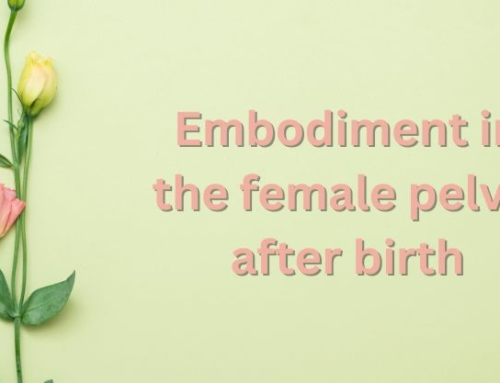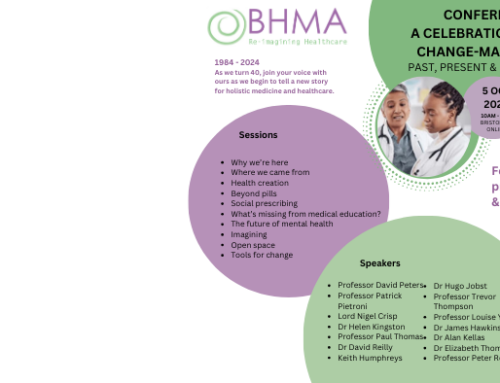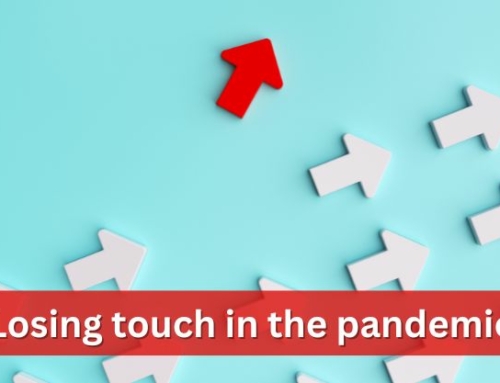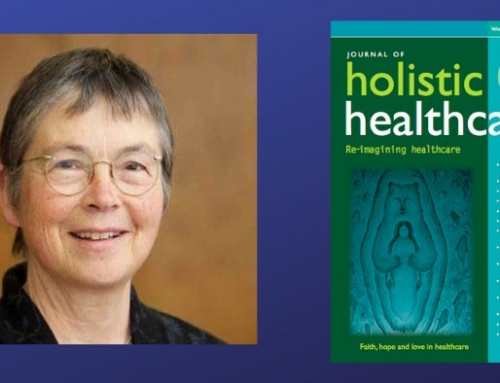I have set myself the task of generating ideas that might help the BHMA in its 20th anniversary ‘business plan’[i]. I am wholly behind the original aim ‘to educate the medical profession and the public on the principles of holism for a health care system that was beginning to lose its soul.’ Sadly, the soul has continued to whither away over the past 20yrs despite the efforts of the BHMA. As you know the forces ranged in support of reductionism are formidable, in terms of high profile influence and big money, including the Dept of Health and its political masters, many of the medical institutions, and of course the pharmaceutical industry. However, because holism harmonises so much better with deep human instincts than does reductionism, it will not be necessary to match the reductionists’ resources – an impossible task in any case! However, to stand any chance of making an impact the BHMA needs a larger membership and a higher profile in the health care debate, and I am glad that this is recognised.
Judging from the Holistic Health journal, the BHMA currently seems to address an audience of committed ‘holists’ – at least that is how the journal reads – food for those already hungry for holism. There is a huge potential constituency for holism out there amongst the general public and especially within the NHS, but I think people are not being reached because the style of the message is in a language that feels unfamiliar and does not relate enough to their everyday frustrations, worries and suffering. Too much of the output of the holistic world is about trying different sorts of therapies, most of which are offered privately. I presume this is because it is relatively easy to express holistic ideas in terms of CAMS, and there is commercial pressure to do so. Of course CAMs are important and valuable (we have a CAM practitioner suite at our surgery) but this emphasis renders the BHMA too easily sidelined by the establishment. A CAM-orientated message is not likely to attract sceptics, or even the busy, ‘only-just-coping’ GP, nurse or NHS manager. They will see the CAM message as an optional extra – a luxury, whereas holism should be a different and deeply transformative way of thinking.
I suggest BHMA should target the NHS for increased membership and enhanced influence. If NHS clinicians and managers are exposed to holistic ideas in a way that clearly relates to their everyday experience, and in a language they feel comfortable with, the tide of the debate might change. Perhaps the easiest way of doing this would be to produce a sister publication aimed at the NHS.
Other holistic organisations and publications
A good first step towards this would be to look at what publications already exist and cover some of the field of holism – in other words take a look at the competition! I am not an advocate for the commercial world – consumerism is in large part responsible for the malaise our society is suffering – but if the BHMA is serious about expansion, there are important lessons to learn from commercial expertise. These are journals I happen to know about. There are no doubt others.
Heath Matters
This journal is aimed at a lay, and NHS professional readership. It is published quarterly by an independent non-profit making company. It is refreshingly challenging, attractively presented, and comments on current controversial issues. It carries very limited non-commercial advertising and has a small correspondence section. No articles extend beyond two sides and most are shorter than that. However, it is significantly left wing politically, reading a little like a trades union newsletter in places. It speaks on behalf of disadvantaged minorities, and women (most NHS employees are female) in particular – of ‘out groups’ – and is consistent and explicit about this (unlike HM Govt which speaks with fork tongues!).
Synovium
This is ‘an occasional newsletter’ produced by the Primary Care Working Group of the Arthritis Research Campaign. It is seriously short – 2 sides of A4! The current issue[ii] has an editorial, three articles, an ‘in brief’ news section, a ‘thought for the day’, and a rheumatology website promotion. It is aimed a GPs and looks through a subtly holistic lens at joint and bone disease. It is sufficiently short to be read by GPs, sufficiently scientific to credible, and sufficiently practical to be useful. There is no advertising other than an invitation to visit the ARC website.
British Medical Journal
Under Richard Smith’s editorship this famous weekly journal has managed to embrace holistic ideas without compromising its standing as a major peer-reviewed international journal carrying reports of significant scientific advances. Several of its themed issues have focused on holistic subject matter:
The Patient[iii]; Time to untangle doctors from drug companies[iv]; Doctors’ wellbeing[v]; Too much medicine[vi]; Health of the excluded[vii]; Integrated medicine: orthodox meets alternative[viii].
Each themed issue assembles a selection of articles, sometimes giving opposing views. As you can see from the publication dates most of the recent themed issues have been holistically orientated. The non-themed issues also often carry papers at least sympathetic to holistic views. Articles are mostly short – up to 3 sides. It has a huge circulation and a magnificent website with opportunities for on-line debate and guaranteed publication of non-libellous letters. Of course, the BMJ is heavily dependent on commercial advertising, and has to take care of its scientific credibility.
Open Mind
This is a magazine produced by the mental health charity MIND. It is bimonthly, very attractively presented and aimed at readership of NHS mental health professionals and the public. The articles are short – max 2 sides – and cover many holistic issues. Like Health Matters, it is aimed at the mainly female mental health workforce, including risqué subjects such as the role of love in the nurse-patient relationship[ix] (no 122 July/August 03). There is no commercial advertising, but it has no correspondence section and is clearly speaking on behalf of ‘service users’, with bias against the use of drugs, and almost a fervour against any hint of paternalism.
A new-look BHMA?
Where should the new ‘face’ of the BHMA sit in relation to these publications and others? I do not know of a journal or magazine devoted to promoting holism and aimed at the NHS as a whole, so there is an opportunity for BHMA to fill that gap. I would suggest the following ingredients for a publication with an appeal to the NHS workforce:
- Subject matter that deals with the reality of everyday suffering and NHS working conditions.
- Short articles – absolute maximum 2 sides.
- Style of writing that recognizes that the life of most NHS staff is dominated by science and technology, targets and budgets, and most clinical staff have been trained almost exclusively as scientists, and imbued with a demand for evidence – so articles must be tightly constructed and rigorously argued – but still short and holistic –possible but hard! This does not preclude spiritual matters, the soul, poetry and similar subjects so long as the language is that of the average NHS professional, and they are short.
- Authorship of every entry made very clear – including enough information for the reader to make a judgement about the reliability of the content – name and qualifications are not enough. NHS or academic staff are likely to carry more weight.
- Items reflecting current hot topics within the NHS, with bold/controversial positions (well argued – and no room for cosiness).
- Some debates presenting opposing views on important subjects.
- Coverage of CAMS that reflects its level of use within the NHS – limited.
- Avoidance of overtly political positions.
- Correspondence should be encouraged as much as possible.
- Balance of primary care and secondary care oriented articles to reflecting the size of each workforce.
- Lively and attractive presentation with pages composed for visual appeal (see Health Matters).
- No commercial advertising.
I realize this is a tall order! It could start in a very small way, but if the resources would not stretch to a second publication, there would have to be some difficult choices. The present journal would need a fairly radical revamp to fit the above criteria, and I imagine some loss of appeal to the present readership. However, a publication such as I describe would also have interest to the public – provided it avoided jargon and over-reliance on technical language – good discipline anyway. Looking again toward the NHS would inevitably require a significant change in thrust of the BHMA as a whole – but this could be invigorating!
Dr William House
St Augustines Practice
Keynsham, BRISTOL
July 2003





